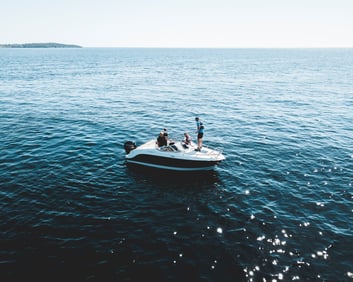In the News: "Mike Farr dived off a friend’s ski boat into Folsom Lake moments after his 11-year-old son sank below the churning waters while bodysurfing in the vessel’s wake. “I swam as deep as I could and as far as I could,” said Farr, his voice cracking. “I expected to catch an arm, but there was nothing.” An autopsy after the accident on May 28 revealed the boy had been knocked out by carbon monoxide fumes and then drowned, making young Anthony Farr a new victim of boating’s dirty little secret: CO poisoning."
Statistics
The Center for Disease Control began studying carbon monoxide poisoning related to boats in 2000. Since then over 800 incidents of CO poisoning and 140 deaths have been reported in 35 states. Dangerous concentrations of carbon monoxide can accumulate in seconds.
What is It?
Carbon monoxide is a colorless, odorless, and tasteless gas. It is produced when a carbon-based fuel such as gasoline, propane, charcoal, or oil burns incompletely. On a boat, the most obvious source of CO is the engine, but it can also come from any onboard generators or cooking ranges. CO enters the bloodstream through the lungs, blocking oxygen the body desperately needs. Symptoms of CO poisoning include irritated eyes, headache, nausea, weakness, and dizziness. Because these symptoms are so similar to seasickness, those affected rarely receive the appropriate medical attention.
Safety Tips
CO is a natural by-product of combustion, making it impossible to completely eliminate, but a few simple steps can help keep carbon monoxide from poisoning you and your passengers.

- Know how and where CO may accumulate in and around your boat.
- Know where engine exhaust outlets are located and keep everyone away from these areas.
- Never sit, teak surf, or hang on the back deck or swim platform while the engines are running.
- It is impossible to smell CO, but if you smell exhaust then CO is present. Take action to dissipate these fumes immediately.
- Treat all symptoms of seasickness as possible CO poisoning. Get the person into fresh air immediately. If a passenger loses consciousness, immediately administer CPR. If emergency oxygen is available, provide 100% oxygen.
- Install CO alarms inside your boat if it has an awning or similar feature that may trap exhaust near the boat.
- Make sure ski ropes are an appropriate length.
- Always wear a life jacket. If someone passes out and falls overboard, this could save their life!
Boat Operation Checklist
Each Trip Checklist
- Make sure you know where exhaust outlets are located on your vessel.
- Educate all passengers about the symptoms of CO poisoning and where CO may accumulate.
- When docked, or rafted with another boat, be aware of exhaust emissions from the other boat.
- Confirm that water flows from the exhaust outlet when the engines and generator are started.
- Listen for any change in exhaust sound, which could indicate an exhaust component failure.
- If applicable, test the operation of each CO alarm by pressing the test button.
- Remove all knots intended to shorten ski ropes.
Boater’s Monthly Maintenance Checklist
- Make sure all exhaust clamps are in place and secure.
- Look for exhaust leaking from exhaust system components. Signs include rust and/or black streaking, water leaks, or corroded or cracked fittings.
- Inspect rubber exhaust hoses for burned, cracked, or deteriorated sections. All rubber hoses should be pliable and free of kinks.
Annual Checklist
Have a qualified marine technician:
- Replace exhaust hoses if cracking, charring, or deterioration is found.
- Ensure that your engines and generators are properly tuned and well maintained.
- Inspect each water pump impeller and the water pump housing. Replace if worn. Make sure cooling systems are in working condition.
- Inspect all metallic exhaust components for cracking, rusting, leaking, or loosening. Make sure they check the cylinder head gasket, exhaust manifold, water injection elbow, and the threaded adapter nipple between the manifold and the elbow.
- Clean, inspect, and confirm proper operation of the generator cooling water anti-siphon valve (if equipped).




